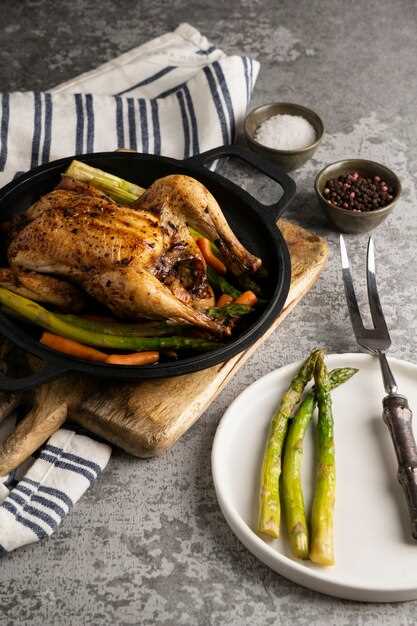Achieve perfectly seared, juicy fowl flank steak in under 30 minutes using this straightforward method. Forget laborious preparation; this guide focuses on maximizing flavor with minimal effort, yielding exceptional results even for novice cooks.
Optimal internal temperature for lean ground fowl flank steak is 165°F (74°C). Using a meat thermometer is highly recommended to prevent dryness. We suggest a marinade time of at least 1 hour, but for intensified tastes, marinate overnight. Ingredients like Worcestershire sauce and smoked paprika add depth and complexity.
Critical for success: Sear the seasoned poultry cut quickly on high heat – this develops a rich crust while keeping the center tender. Let the prepared cut rest for 5-10 minutes before slicing against the grain; this maximizes tenderness and enhances the dining experience. Pair with a vibrant chimichurri sauce or a simple lemon-herb dressing.
Selecting the Perfect Avian Cut for Flank Steak Preparation
Opt for the avian breast, specifically a boneless, skinless cut, for optimal results. Its uniform thickness promotes consistent cooking and mimics the texture desired in flank steak imitations.
Seek out a breast averaging 1.5 to 2 inches thick. Thinner portions dry out rapidly under intense heat, while thicker ones require extended cooking, increasing toughness.
Consider the weight. A 1.5 to 2 pound avian breast typically serves 4-6 individuals. Adjust accordingly for larger gatherings or meal prepping.
Inspect the cut for color. Fresh avian breast should exhibit a pinkish hue, not grey or discolored patches. Avoid product with excessive surface moisture, which can indicate poor handling or aging.
Feel the breast. It should be firm to the touch, not slimy or overly soft. This indicates quality and freshness, contributing to a superior cooked outcome.
Marinade Magic: Flavor Secrets for Prepared Flank Steak
For enhanced flavor, marinate the flank steak for at least 4 hours, or up to 24 hours in the refrigerator. A mixture of 1/4 cup balsamic vinegar, 2 tablespoons olive oil, 2 cloves minced garlic, 1 tablespoon Dijon mustard, 1 teaspoon dried thyme, 1/2 teaspoon smoked paprika, salt and freshly ground black pepper to taste will yield a robust, savory taste.
Acidic Balance
The key to a successful marinade lies in the acidic component. Acids, such as vinegar or lemon juice, tenderize the meat fibers. Avoid excessively acidic marinades, as they can cause the protein to become mushy after extended exposure. Test with a small sample first.
Flavor Infusion Tips
Introduce umami richness with 1 tablespoon of Worcestershire sauce or soy sauce to the marinade. Finely grated ginger (1 teaspoon) brings a subtle warmth. Consider adding a pinch of red pepper flakes for a slight heat. For a sweeter profile, incorporate 1 tablespoon of brown sugar or honey.
Grilling to Perfection: Temperature and Timing Guide
For achieving an optimally cooked flank steak on a grill, preheat to medium-high heat (375-450°F or 190-230°C). Aim for an internal temperature of 130-135°F (54-57°C) for medium-rare, 135-140°F (57-60°C) for medium, or 140-145°F (60-63°C) for medium-well. Use a meat thermometer for accuracy.
Precise Timing for Perfection
Grill the flank steak for approximately 4-5 minutes per side for medium-rare, adjusting based on thickness. A thinner cut requires less time. Rotate it 45 degrees halfway through cooking each side to create visually appealing diamond grill marks. Always check the internal temperature rather than relying solely on time.
Achieving Optimal Sear
For an enhanced crust, sear the flank steak over direct high heat for 1-2 minutes per side prior to moving it to indirect heat to finish cooking. Ensure you don’t burn the outer surface. Monitor for flare-ups and move the slab away from the flame as needed.
Resting Period: Allow the grilled steak to rest for 10 minutes before slicing against the grain. This allows the juices to redistribute, resulting in a more tender and flavorful dish. Tent loosely with foil.
Important Note: Cooking times may vary depending on the grill and the thickness of the cut. Use a reliable instant-read thermometer to ensure accurate results.
Slicing and Serving: Maximizing Taste and Presentation
Slice the fowl roast thinly against the grain. Angling the blade at 45 degrees maximizes surface area, enhancing tenderness and perceived portion size.
Serving Temperature
Allow the fowl to rest for 10-15 minutes before carving. This redistributes juices, producing a moister, tastier result. Aim for an internal temperature of 145°F (63°C) before resting, allowing it to climb to 150-155°F (66-68°C) during the rest period.
Plating Suggestions
Arrange the sliced meat on a warm platter, slightly overlapping each piece. Garnish with fresh herbs like rosemary or thyme. Serve alongside complementary side dishes such as roasted vegetables (asparagus, Brussels sprouts) or a creamy potato gratin. A light pan sauce or gravy complements the savory notes.
Q&A:
My family doesn’t like strong flavors. Can I adjust the marinade to make it milder?
Absolutely! The marinade is easily customizable. If you want a milder flavor, reduce the amount of Worcestershire sauce or balsamic vinegar. You could also add a touch more olive oil or a little honey to mellow out the tanginess. Taste the marinade before you add the turkey and adjust seasonings to your preference. A little lemon juice can also brighten the flavor without making it too strong.
What’s the best way to tell when the turkey London broil is done cooking, without drying it out?
The most accurate way is to use a meat thermometer. Aim for an internal temperature of 165°F (74°C) at the thickest part of the turkey. Avoid overcooking, as it can become dry. Another method is to press gently on the surface of the turkey; it should feel firm but still have a slight give. If you don’t have a meat thermometer, cut into the center. The juices should run clear, and there should be no pinkness.
I don’t have a broiler. Can I cook this turkey London broil on the grill or in a pan on the stovetop?
Yes, both grilling and pan-searing are great alternatives! For grilling, preheat your grill to medium-high heat and cook the turkey for about 5-7 minutes per side, or until it reaches 165°F (74°C). For pan-searing, use a heavy-bottomed skillet or cast iron pan. Heat some olive oil over medium-high heat and sear the turkey for 4-6 minutes per side, then reduce the heat to medium and continue cooking until it is done. Remember to let it rest after cooking, regardless of the method.
I’m planning to make this for a large group. Can I prepare the turkey London broil ahead of time?
You can definitely prep ahead! The best way is to marinate the turkey overnight or for up to 24 hours. This will allow the flavors to really penetrate the meat. However, avoid marinating for much longer than 24 hours, as the acid in the marinade can start to break down the turkey and make it mushy. You can also chop all your vegetables ahead of time. When ready to cook, just follow the recipe instructions. Cooked turkey London broil can be stored in the refrigerator for up to 3-4 days.
What are some good side dishes to serve with this turkey London broil?
This dish is quite versatile, so many sides work well. Roasted vegetables like asparagus, broccoli, or sweet potatoes are excellent choices. A simple salad with a vinaigrette dressing provides a nice contrast. You could also serve it with rice, quinoa, or mashed potatoes. If you want something heartier, consider a corn casserole or grilled corn on the cob. Really, anything you’d typically serve with grilled meat will complement the turkey London broil.



